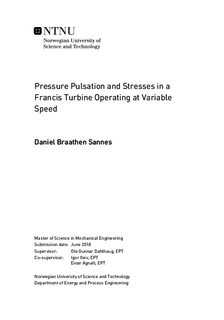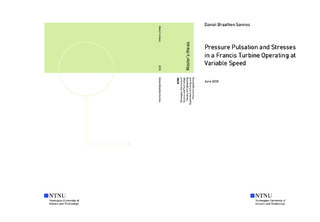| dc.description.abstract | The introduction of new intermittent energy sources on the electrical grid increases the need of regulated power to ensure stability of grid frequency. Hydropower has the unique possibility to deliver both stability and flexibility in energy production. Due to this, turbines is operating tougher, with more starts and stops and operations outside BEP. In addition, there are more fluctuations on the grid and the turbines is experience more dynamical loading, which can increase damages on the turbine structure. Today, the industry is facing problems with both new and old high head Francis units and the main problem is the formation of cracks in the runner due to pressure fluctuations. It is therefore important to develop new methods for reducing dynamical effects and thereby reducing the fatigue load on the Francis runner. In the latest years, the focus on flexibility have increased and turbines with variable speed capabilities of more interest. Variable speed operations gives the opportunity to change the operation pattern and operate at different speeds. The main objective of this work is to find the operating range for the Francis turbine at the Waterpower Laboratory at NTNU, with variable speed, which gives the lowest material stresses.
To approach this objective, measurements of both efficiency and pressure pulsations for the whole operating range of the Francis turbine has been conducted. Peak-peak values from pressure pulsations have been presented in pressure pulsation diagrams, which is inspired by the Hill Chart. One diagram was made for each pressure sensor. By analyzing these diagrams, it is possible to find out where the turbine can be operated in order to minimize the effect of pressure pulsations. Frequency analysis was conducted for a total of eighteen operation points, for synchronous speed and for reduced speed. The guide vane passing frequency was identified as the most significant in the runner for all operation points.
Structure analysis of the turbine runner was conducted in ANSYS Mechanical, to calculate the stresses due to the pressure pulsations. A flow analysis was conducted in order to calculate the pressure distribution that was applied on the runner blades. Stresses was calculated for BEP, PL and ML for synchronous speed and reduced speed. The stresses at synchronous speed was compared to the once were the speed was reduced to investigate the relative change. Stresses was further used in a fatigue assessment, where accumulated damage was calculated. The results are showing that by reducing the speed the stresses are reduced for part load operations. Fatigue assessment showed that by reducing the speed for part load operation, the accumulated damage drastically dropped. | |

